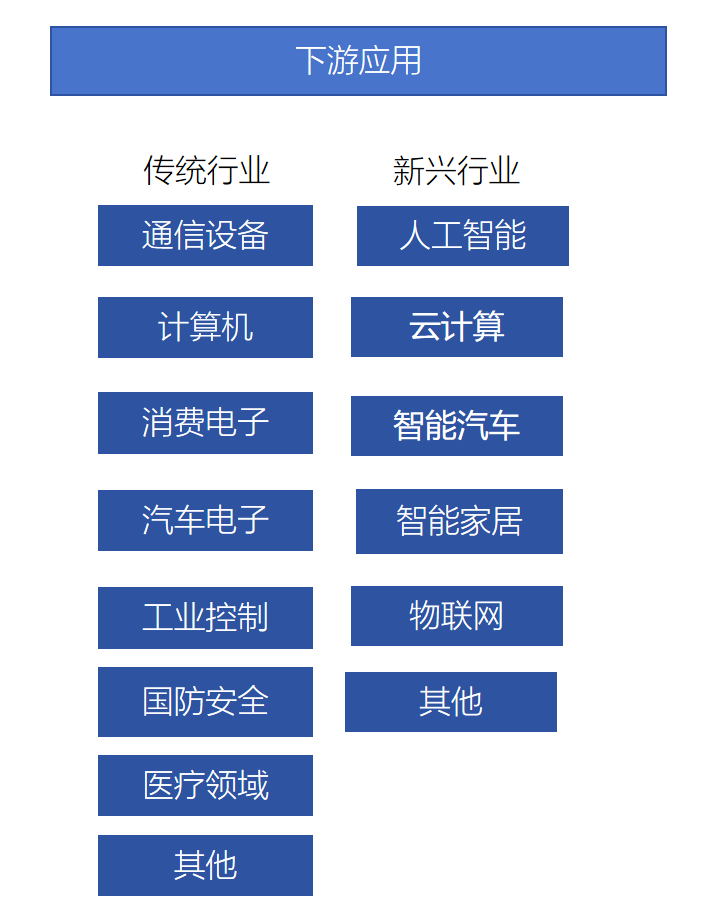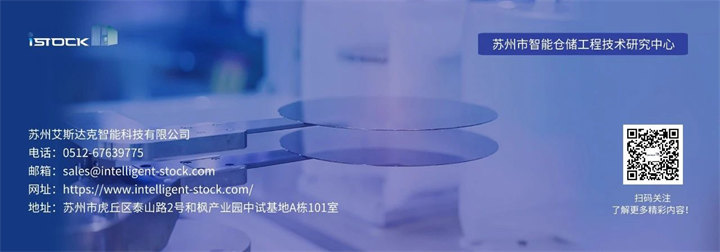How to distinguish between semiconductors, integrated circuits, and chips?
Firstly, from a product perspective, semiconductors can be said to be the foundation of integrated circuits and chips, and the three are interdependent and mutually reinforcing.
Specifically, let's take a look:
Semiconductors are materials that exhibit different conductivity properties under different temperature conditions. At higher temperatures, semiconductors have better conductivity; At lower temperatures, it exhibits poor conductivity, even approaching that of an insulator. This type of material typically has a resistivity between that of a conductor and an insulator.
Integrated Circuit (IC) is a technology that integrates multiple electronic components such as transistors, capacitors, resistors, etc. onto a small semiconductor chip. These components are connected through intricate circuits to form complex circuit structures, capable of performing various functions such as computation, control, and signal processing. Integrated circuits make electronic devices smaller and more efficient.
A chip is the specific implementation form of an integrated circuit, which is manufactured on a semiconductor substrate according to a specific design layout and connection method. The chip integrates a large number of electronic components internally and is made into a compact whole through fine craftsmanship. This highly integrated approach makes chips the core components of modern electronic devices.
According to the classification standards of the World Semiconductor Trade Statistics Organization (WSTS), integrated circuits can be mainly divided into the following categories:
Analog Integrated Circuit (IC): Used to process continuously changing signals, such as amplifiers, filters, etc.
Micro IC: including microprocessors (CPU), microcontrollers (MCU), etc., used to perform digital operations and control tasks.
Logic IC: Used to implement digital logic functions such as gate circuits, flip flops, etc.
Memory IC: Used for storing data, including RAM (Random Access Memory), ROM (Read Only Memory), Flash (Flash Memory), etc.
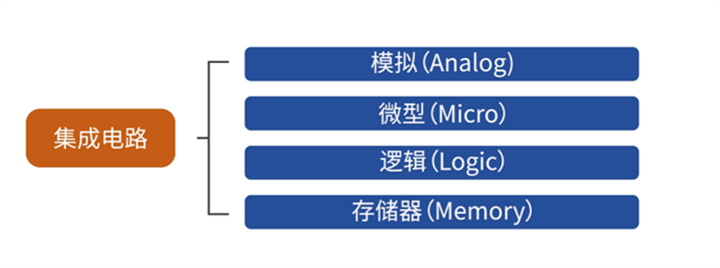
Normally, chips can be classified into consumer grade, industrial grade, automotive grade, military grade, and aerospace grade according to their levels; According to the design concept, it can also be divided into general-purpose chips (CPU, GPU, etc.) and dedicated chips (AISC); Or divided according to the manufacturing process, there will be commonly heard 28nm, 14nm, 7nm, and 5nm; Alternatively, according to semiconductor materials, they can be divided into silicon (Si), germanium (Ge), gallium arsenide (GaAs), gallium nitride (GaN), and so on.
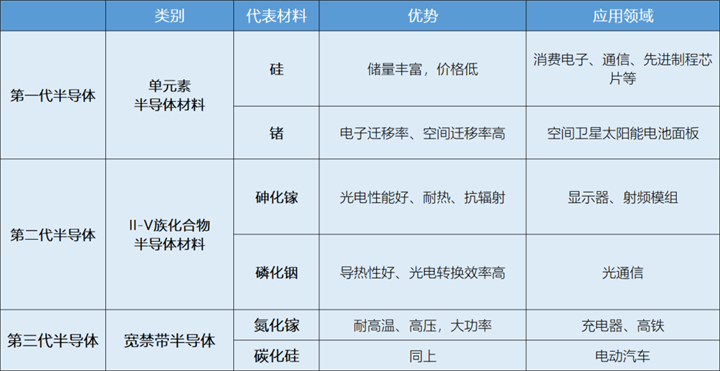
What is the significance of the semiconductor industry?
A Grain of Sand in the Information Age
The main raw material for semiconductors is actually silicon dioxide (SiO ₂) in sand, commonly known as quartz sand. Through a series of chemical and physical processes, quartz sand can be converted into high-purity silicon, which is an important foundational material for manufacturing semiconductor devices.
Chips made of semiconductor materials are the core components of modern electronic devices, equivalent to the "brain" of the equipment. These chips integrate a large number of transistors and other electronic components, providing powerful computing power and data storage capabilities. Whether it's smartphones, computers, or other high-tech products, they all rely on the support of semiconductor chips.
To some extent, the semiconductor industry is indeed one of the most important industries in the world today. In the information age, semiconductor chips have become the fundamental building blocks for numerous products and services. Just like every grain of sand on the beach may seem ordinary, but it plays a crucial role in modern technology.
The 'technological mountain' of advanced manufacturing world
From the perspective of the industrial chain, the semiconductor industry is a highly specialized and clearly divided industry. The entire industry chain covers upstream raw material supply, midstream chip design and manufacturing, downstream packaging and testing, and ultimately integrating chips into various electronic terminal products. The technology and processes involved in this process are very complex, covering a wide range of industries.
From the perspective of industrial development, the semiconductor industry can be said to be a "technological highland" in the field of advanced manufacturing. It not only requires a high level of technological accumulation and innovation capability, but also reflects the overall strength and development level of the country in high-end manufacturing. Therefore, the semiconductor industry largely symbolizes a country's high-tech manufacturing capabilities.

Semiconductor industry chain
Semiconductor upstream raw material supply chain
semiconductor material
Semiconductor materials are mainly used in wafer manufacturing and chip packaging processes, including but not limited to the following:
Silicon wafer: Silicon wafer is the most basic material in semiconductor manufacturing, and its quality directly affects the performance of chips. The main suppliers include Shin Etsu Chemical and SUMCO from Japan, and Siltronic AG from Germany.
Photoresist: Photoresist is a key material in photolithography processes, used to transfer circuit patterns onto silicon wafers. The main suppliers include Japan's JSR Corporation and Tokyo Applied Chemicals (TOK).
Mask (mask plate): The mask is used to store circuit patterns and ensure the accuracy of the photolithography process. The main suppliers include Hoya Corporation and DNP (Greater Japan Printing) from Japan.
Chemicals: Used for cleaning, etching, doping and other processes. The main suppliers include Air Products&Chemicals from the United States and Stella Chemifa Corporation from Japan.
Target material: used for thin film deposition process. The main suppliers include Hitachi Metals from Japan.
Gas: Used for processes such as chemical vapor deposition (CVD). The main suppliers include Linde from the United States and Taiyo Nippon Sanso from Japan.
Semiconductor equipment
Semiconductor equipment is the core tool for semiconductor manufacturing, mainly including:
Oxidation furnace: used for oxidation treatment of semiconductor surfaces.
Coating and developing equipment: used for coating and developing photoresist.
Lithography machine: used to transfer circuit patterns onto silicon wafers. The main suppliers include ASML from the Netherlands.
Etching machine: used to remove unwanted material layers. The main suppliers include Lam Research from the United States and TEL (Tokyo Electronics) from Japan.
Ion implantation machine: used for doping process. The main suppliers include Axcelis Technologies from the United States and Hitachi Kokusai Electric from Japan.
The advancement of these devices and technologies not only drives the development of semiconductor manufacturing processes, but also greatly improves the performance and reliability of semiconductor products. Therefore, semiconductor equipment is regarded as an important cornerstone for the development of the semiconductor industry.
In summary, semiconductor materials and equipment are the two pillars of the semiconductor industry, jointly supporting the entire process from wafer manufacturing to chip packaging.
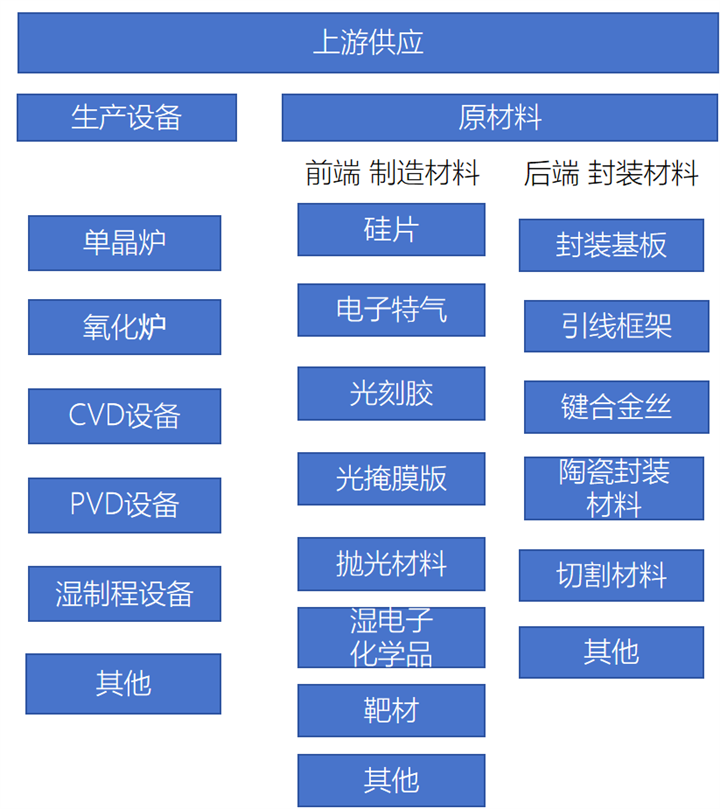
Semiconductor midstream manufacturing industry chain
The semiconductor midstream manufacturing industry chain mainly includes three core links: integrated circuit (IC) design, manufacturing, and packaging testing. The specific process is as follows:
IC design:
IC design companies design chips that meet the requirements of downstream electronic system manufacturers. This includes selecting the appropriate architecture, designing circuit diagrams, and using EDA (Electronic Design Automation) software for simulation and validation.
Wafer manufacturing:
After the design is completed, the design drawings will be sent to the wafer foundry. Wafer foundries use advanced manufacturing processes such as oxidation, sputtering, photolithography, etching, ion implantation, etc. to transfer designed circuit diagrams onto silicon wafers, forming integrated circuits.
Encapsulation testing:
The completed wafers are sent to the packaging and testing factory. The packaging and testing factory will cut, package (install the chip inside the packaging body to protect it from external environmental influences), and test (verify whether the functionality and performance of the chip meet the requirements) each chip on the wafer.
After packaging testing, qualified chips are packaged into final integrated circuit products, ready to be sold to downstream system manufacturers.
Main product types
Integrated Circuit (IC): An IC is a miniature electronic device that integrates multiple electronic components onto a single chip, widely used in fields such as computers, communication devices, and consumer electronics.
Discrete devices: Discrete devices refer to independent components that are not packaged into integrated circuits, including diodes, transistors, resistors, capacitors, etc., each of which performs specific electronic functions. For example, diodes are used for rectification, transistors are used for amplifying signals, resistors are used to regulate voltage, and capacitors are used to store charge.
Optoelectronic devices: Optoelectronic devices, also known as photosensitive devices, work based on the photoelectric effect. Common optoelectronic devices include photoresistors, photodiodes, photovoltaic cells, etc. These devices are widely used in fields such as optical communication and optoelectronic sensing.
Sensor: A sensor is a detection device that can sense the information being measured and convert it into usable electrical signals. Sensors usually consist of four parts: sensitive components, conversion components, conversion circuits, and auxiliary power supplies. Common types of sensors include temperature sensors, pressure sensors, acceleration sensors, etc.
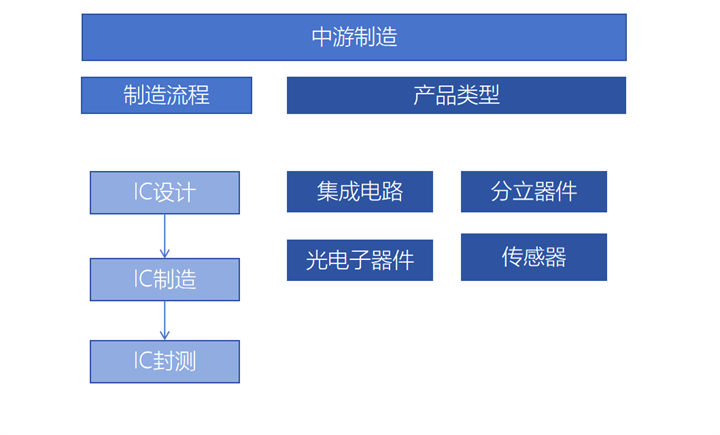
Semiconductor downstream application industry chain
Traditional application areas
Communication: including mobile phones and other wireless communication devices. These devices rely on high-performance semiconductor devices to achieve data transmission and processing.
Computers: including personal computers, servers, and data centers. Computers require a large number of high-performance processors, memory, and other critical semiconductor components.
Consumer electronics: including televisions, speakers, game consoles, etc. These devices require multiple semiconductor devices to support their functionality and performance.
Automotive electronics: including in car entertainment systems, safety systems, power control systems, etc. With the improvement of automobile intelligence, the demand for semiconductor devices is also constantly increasing.
Industrial control: including automated production lines, robots, etc. Semiconductor devices play a crucial role in industrial control, ensuring system stability and efficiency.
Emerging application areas
Artificial intelligence: including machine learning, deep learning, etc. The development of artificial intelligence technology requires a large amount of high-performance computing power and efficient storage solutions, which puts higher demands on semiconductor devices.
Cloud computing: including data centers, cloud services, etc. Cloud computing requires a large number of high-performance servers and storage devices, which rely on advanced semiconductor technology.
Intelligent vehicles: including autonomous driving, connected vehicles, etc. Smart cars require highly integrated sensors, processors, and communication modules, all of which require high-performance semiconductor devices.
Smart home: including smart speakers, smart home appliances, etc. Smart home devices require low-power, highly integrated semiconductor devices to achieve intelligent functions.
Internet of Things: including sensor networks, smart devices, etc. IoT devices require miniaturized, low-power semiconductor devices to achieve interconnectivity.
